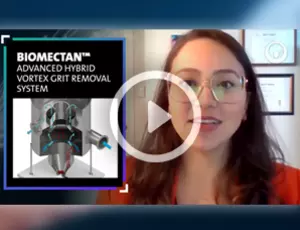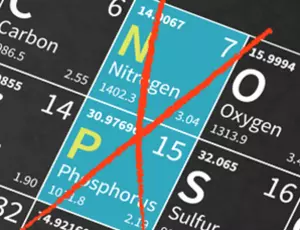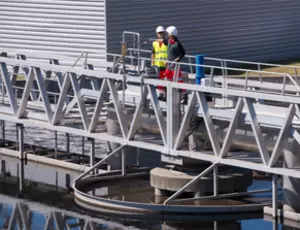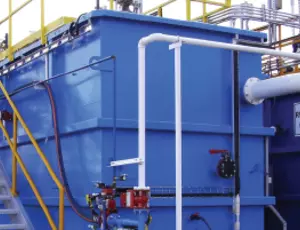Biological treatment of wastewater is a very effective and common treatment step in many industrial and municipal wastewater facilities.
Harnessing the power of bacterial and other micro-organisms, biological wastewater treatment is an economic way to breakdown organic contaminants from a wide variety of wastewater streams.
Biological Wastewater Treatment Technologies are a critical component in many wastewater treatment systems. These systems are an effective tool to breakdown organic material and other pollutants to help organizations meet discharge permit requirements and reduce sewer surcharges.
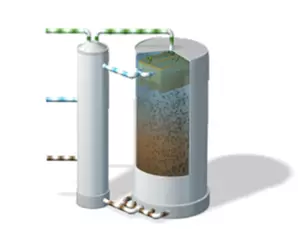
Anaerobic Wastewater Treatment
Anaerobic wastewater treatment processes use bacteria to break down BOD (Biological Oxygen Demand), COD (Chemical Oxygen Demand), and other organic contaminants with the absence of oxygen. Anaerobic systems do not require the addition of air to the reactors, which lowers energy costs to operate the system. In many instances, anaerobic digestion systems can be energy positive. Anaerobic systems are also able to treat wastewater that has higher concentrations of BOD/COD.
During the anaerobic digestion process, the bacteria create biogas as a by-product that can be harvested and utilized in an electrical generator or boiler. Anaerobic digestion also generally produces lower amounts of sludge, when compared to aerobic systems.
Common Anaerobic Systems:
- High Rate - Granular Anaerobic Digestion (UASB - Upflow Anaerobic Sludge Bed & EGSB - Expanded Granular Sludge Bed)
- Medium Rate - Anaerobic MBR (Membrane Bio Reactors)
- Low Rate - CSTR (Continuously Stirred Tank Reactor)
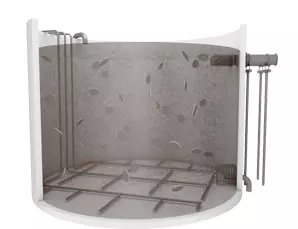
Aerobic Wastewater Treatment
Aerobic wastewater treatment systems include the addition of air (oxygen) within the wastewater reactor. These systems are effective in reducing BOD/COD to very low levels. In many, cases aerobic systems are used in conjunction with anaerobic systems to polish wastewater streams to remove nutrients or polish prior to discharge. These systems are also very resilient to variations in temperature and can effectively be used in almost any climate. Also, these systems can be installed in series or combined together to increase treatment capacity.
Common Aerobic Systems
- MBBR (Moving Bed Biofilm Reactors)
- Activated Sludge
- Aerobic MBR (Membrane Bioreactors)
- Lagoons
- Sequencing Batch Reactors
- Oxidation Ditches
FAQ's
What is Anaerobic Digestion?
What is Anaerobic Digestion?
Anaerobic digestion is a highly efficient and widely used biological wastewater treatment process for green energy production and stabilizing sludge. Digestion converts organic solids to biogas, significantly reducing the amount of sludge requiring disposal (up to 40%), while at the same time improving its final dewaterability. The biogas produced can be utilized for heat and power production while disposal costs for the sludge are significantly reduced. Therefore anaerobic digestion is an effective method to reduce costs and generate income for a wastewater treatment plant.
Where is Anaerobic Digestion Used?
Where is Anaerobic Digestion Used?
Anaerobic wastewater treatment systems are utilized in municipal applications along with a variety of industries. These industries include breweries, dairies, pulp and paper mills, chemical processing plants, and biofuels.
What Are Common Anaerobic Wastewater Treatment Systems?
What Are Common Anaerobic Wastewater Treatment Systems?
Common Anaerobic Systems Used in Wastewater Treatment Include:
- High Rate - Granular Anaerobic Digestion Systems: These small-footprint anaerobic systems utilize specialized granular biomass to consume dissolved organics. Installed inside at the top of the reactor is an advanced three-phase settler. This settler separates the treated water from the produced biogas while allowing the biomass to settle back down into the reactor.
- Medium Rate Systems: These systems treat industrial wastewater streams with significantly high amounts of suspended solids. It is the anaerobic equivalent to the conventional activated sludge digestion system and utilizes suspended biomass to break down organics. Another specific medium rate system is an Anaerobic MBR. These systems are paired with UF membranes to provide a very high-quality effluent.
- Low Rate: These systems are similar to medium rate systems. They also utilize a CSTR, but they require significantly longer retention times and can treat waste streams that are high in TSS, when compared to High and Medium Rate Systems.
What is Aerobic Digestion?
What is Aerobic Digestion?
Aerobic digestion is the breakdown of organic sludge solids in the presence of oxygen. Aerobic wastewater treatment systems include the addition of air (oxygen) within the wastewater reactor.
What Are Common Aerobic Wastewater Treatment Systems?
What Are Common Aerobic Wastewater Treatment Systems?
Common Aerobic Systems Used in Wastewater Treatment Include:
- Conventional activated sludge: In these systems, organic matter is broken down by aerobic microorganisms in an aeration tank. This forms biological flocs (sludge) which are then separated from the treated water in a sedimentation tank.
- Moving bed biofilm reactor (MBBR): In these types of systems, biofilm grows on carriers suspended and circulated in an aeration tank. The carriers create a large total surface area in a very compact footprint, when compared to conventional activated sludge.
- Membrane bioreactor (MBR): These aerobic systems utilize submerged membranes in the aerobic reactor. As a result, it combines the advantages of an activated sludge system with advanced membrane filtration.
- Lagoons: In an area where there is a large amount of land, wastewater can be sent to a lagoon system and aerated to biologically consume the organic contaminants.
Featured Resources & Information




